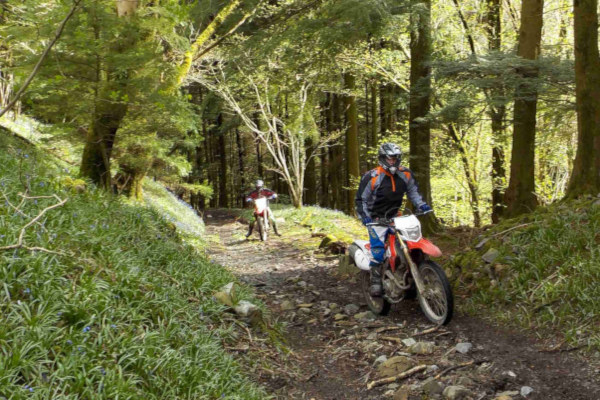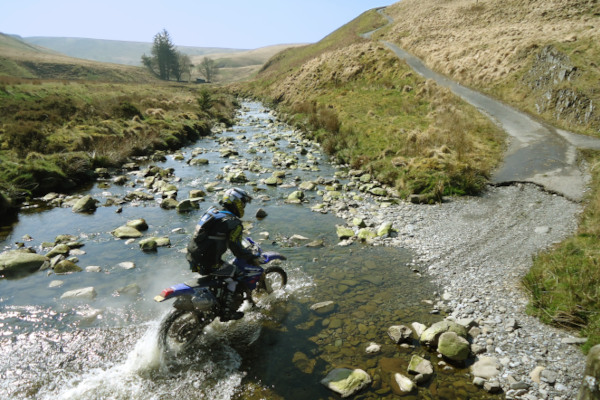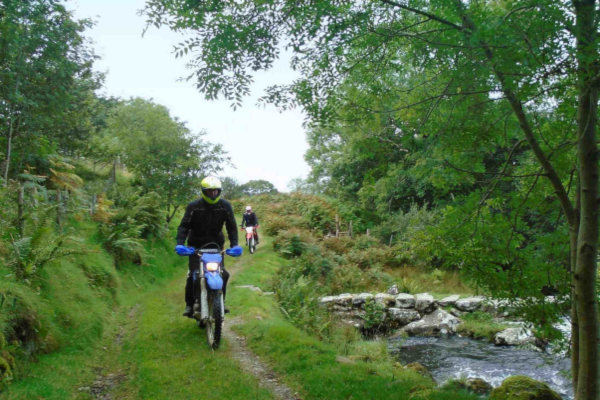New to trail riding with your own bike?
Preparing your bike
Unlike a road bike which you tend to ride very much as it came from the manufacturer, trail and enduro bikes are often modified to suit their owner’s height and weight. When bought new, the bikes are usually supplied with handlebars for the road which are too low for trail riding. If you swap the bars for ones a little higher, the cables should be OK, but if using bar risers, you may find you need to obtain longer throttle and clutch cables.

Not all enduro bikes have fans on their radiators (particularly older bikes, such as DRZ400) so bear in mind if riding in very slow conditions or when waiting at gates, it may overheat.
If your bike needs lowering, it is worth having it done professionally in order to keep the good handling you bought the bike for. Lowering one end without the other can make a bike ride very strangely!
Most trail riders use enduro tyres, but some favour road legal motocross, trials or dualsport. If you are doing a lot of mud, a hard tyre with chunky knobbles will be good on the trail, but terrible on the tarmac road especially if it is wet. If you are riding on a lot of gravel or rock, you may prefer trials or dualsport tyres. If you fear having a puncture, you may prefer to have mousses fitted, but they are not road legal. With mousses it is advised that you make sure wheels are off the ground between rides so that the mousses don’t get flat spots. Be aware that mousses will overheat and break up if you ride fast on tarmac for more than a few miles.
Modern enduro bikes are lightweight, and their stands are only designed to support the bike. It may break if you get on and off with the stand down, so it is worth getting used to putting it up before you get on, and after you get off.
WaterWater is risky! Water in your engine is to be avoided at all costs! If you are riding through puddles or streams more than about 6" deep, we advise sitting down so you have a chance of getting a foot down. If you are unlucky and the bike is going over, hit the kill switch if you can. As you will see in the picture, most riders do stand up through water!

If the bike goes under, check there is no water in the air filter before trying to start. If you have electric start and hit it accidently or deliberately and the piston moves up against water, it cannot escape in a four stroke engine. Either it will bend the valves or the conrod, or both. Two strokes allow the water in the combustion chamber to come out through the ports, so you don’t risk so much damage. First look for a drain plug in the air-box (not all bikes have one). If water comes out or there isn’t a drain plug, take the air filter out and see if any part of it is wet. If it is, take the spark plug out and turn the engine over. If any water comes out, and it is a fuel injected bike with no kickstart, arrange for collection – you won’t be able to dry it out sufficiently on the trail. It can take up to an hour to get water out of the fuel injection system. If it has a carburettor, drain it, and keep turning the engine over until no more water comes through. Also drain water from the exhaust, as it can get into the combustion chamber from the front if you are really unlucky!
How we ride
Riding positionMost of the time, you will get less tired and make better choices if you are standing up. Stand with feet level or heel slightly down, middle of the peg, legs straight but not locked, angled slightly back so that you lean forward at the hips. Keep your legs in touch with the frame or tank, as that stablises the bike. If you find yourself pulling on the bars, make sure you are not crouching or bending your knees, as that has the effect of throwing your upper body back which upsets your balance. Look well ahead, and do not follow another rider too closely, as he will block your view of what is coming up. Many riders cover the clutch and front brake with one or two fingers.

Attack with momentum and confidence in a gear which you think will get you to the top (usually third or second). Cover the clutch with one or two fingers and if the revs are dropping but you are nearly there, slip the clutch. Avoid changing gear on the hill.
Hills downLook well ahead. If the hill is very steep and the surface is loose or slippery, you may not be able to brake much. Start from a standstill or walking pace. Use two fingers on the front brake and a light touch on the rear. As you become more experienced, you will develop a feel for the grip the front is giving you, and will learn to brake as much as is possible, releasing pressure just before losing grip. It is the front which will stop you, although extra pressure on the rear can be useful if there is a hairpin bend, as you can slide the back round. The slowest you can go is first gear with the clutch out (which can be surprisingly fast!) Never pull the clutch in going downhill – you will go faster, and you have less (no) control!
RutsRuts do not look difficult, but are the feature which cause the most trouble. Look ahead, keep the power gently on with lowish revs/higher gear, and ride smoothly without sudden acceleration or slowing down. If you have to brake, be as gentle as possible. Narrow ruts in the centre of a track caused by motorcycles are often impossible to ride standing up, whereas Landrover or tractor ruts can become easy to ride if they are wide. If the rut is deep, make sure you feet are not vulnerable to being pushed off the peg – it hurts! Really deep or very slippery ruts may need to be ridden sitting down with feet out frontwards or paddling. Do not try to get out of a rut – you never can unless you are some sort of trials or enduro God!
Picking the bike upIf it is possible, pull the handlebar which is lowest to the ground, as far forward as you can. The front wheel will be pointing upwards. Then pick up from the lowest handlebar. This gives more leverage, and makes it easier. Do not grab the mudguards or any plastic parts, as it is likely you will break them.
Doing the gatesIf the ground is uneven or down hill, it is best to stop the engine leaving the bike in gear, as it is less likely to roll off the stand and fall over. You can use the kill switch to stop the engine.
